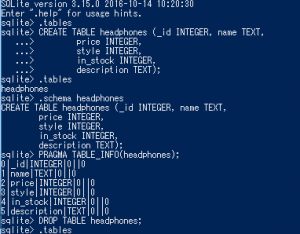DELETE FROM
package com.example.android.pets;
import android.content.Intent;
import android.os.Bundle;
import android.support.design.widget.FloatingActionButton;
import android.support.v7.app.AppCompactActivity;
import android.view.Menu;
import android.view.MenuItem;
import android.view.View;
public class CatalogActivity extends AppCompactActivity {
@Override
protected void onCreate(Budle savedInstanceState){
super.onCreate(savedInstanceState);
setContentView(R.layout.activity_catalog);
// Setup FAB to open EditorActivity
FloatingActionButton fab = (FloatingActionButton) findViewById(R.id.fab);
fab.setOnClickListener(new View.OnClickListener(){
@Override
public void onClick(View view){
Intent intent = new Intent(CatalogActivity.this, EditorActivity.class);
startActivity(intent);
}
});
}
@Override
public boolean onCreateOptionsMenu(Menu menu){
// Inflate the menu options from the res/menu/menu_catalog.xml file.
// This adds menu items to the app bar.
getMenuInflater().inflate(R.menu.menu_catalog, menu);
return true;
}
@Override
public boolean onOptionsItemSelected(MenuItem item){
// User clicked on a menu option in the app bar overflow menu
switch (item.getItemId()){
case R.id.action_insert_dummy_data:
return true;
case R.id.action_delete_all_entries:
return true;
}
return super.onOptionsItemSelected(item);
}
}
package com.example.android.pets;
import android.os.Bundle;
import android.support.v4.app.NavUtils;
import android.support.v7.app.AppCompactActivity;
import android.text.TextUtils;
import android.view.Menu;
import android.view.MenuItem;
import android.view.View;
import android.widget.AdapterView;
import android.widget.ArrayAdapter;
import android.widget.EditText;
import android.widget.Spinner;
public class EditorActivity extends AppCompactActivity {
private EditText mNameEditText;
private EditText mBreedEditText;
private EditText mWeightEditText;
private Spinner mGenderSpinner;
private int mGender = 0;
@Override
protected void onCreate(Bundle savedInstanceState){
super.onCreate(savedInstanceState);
setContentView(R.layout.activity_editor);
mNameEditText = (EditText) findViewById(R.id.edit_pet_name);
mBreedEditText = (EditText) findViewById(R.id.edit_pet_breed);
mWeightEditText = (EditText) findViewById(R.id.edit_pet_weight);
mGenderSpinner = (Spinner) findById(R.id.spinner_gender);
setupSpinner();
}
}
private void setupSpinner(){
ArrayAdapter genderSpinnerAdapter = ArrayAdapter.createFromResource(this,
R.array.array_gender_options, android.R.layout.simple_spinner_item);
genderSpinnerAdapter.setDropDownViewResource(android.R.layout.simple_dropdown_item_1line);
mGenderSpinner.setAdapter(genderSpinnerAdapter);
mGenderSpinner.setOnItemSelectedListener(new AdapterView.OnItemSelectedListener(){
@Override
public void onItemSelected(AdapterView<?> parent, View view, int position, long id){
String selection = (String) parent.getItemAtPosition(position);
if (!TextUtils.isEmpty(selection)){
if (selection.equals(getString(R.string.gender_male))){
mGender = 1;
} else if (selection.equals(getSTring(R.string.gender_female))){
mGender = 2;
} else {
mGender = 0;
}
}
}
@Override
public void onNothingSelected(AdapterView<?> parent){
mGender = 0;
}
});
}
@Override
public boolean onCreateOptionsMenu(Menu menu){
getMenuInflater().inflate(R.menu.menu_editor, menu);
return true;
}
@Override
public boolean onOptionItemSelected(MenuItem item){
switch (item.getItemId()){
case R.id.action_save:
return true;
case R.id.action_delete:
return true;
case android.R.id.home:
NavUtils.navigateUpFromSameTask(this);
return true;
}
return super.onOptionsItemSelected(item);
}

